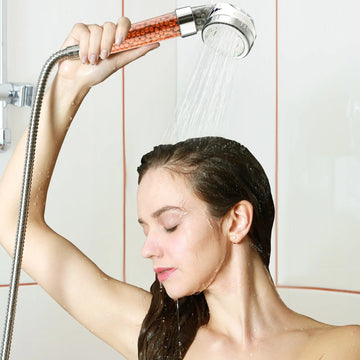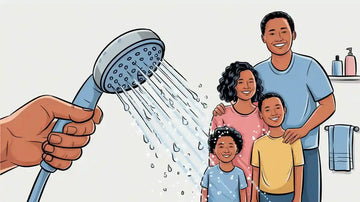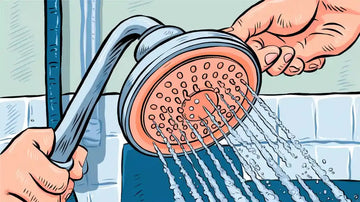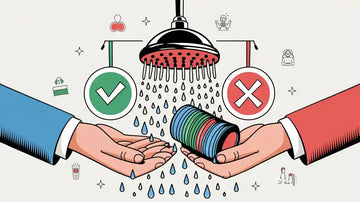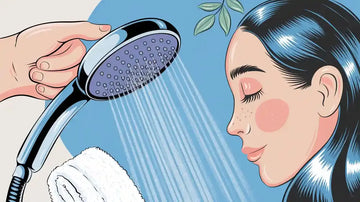Water saving shower heads use science to help people use less water. They still give a strong and comfortable shower. New studies show these showerheads can lower water use by up to 40%. This helps families save more than 1,400 gallons each week. These showerheads have things like flow restrictors, aerators, air-mixing, and smart sensors. These features help cut down water flow and energy use. Many models also have filtration and other ways to save water. This helps keep people healthy and helps the planet. More people want eco-friendly choices now. Water saving shower heads are important for saving water and helping the environment. They help people use water in a better way.
-
Core features found in today’s water-saving showerheads:
Flow restrictors for lower water use
Aerators and air-mixing for comfort
Advanced filtration for cleaner water
Smart sensors for real-time feedback
Key Takeaways
Water-saving shower heads have flow restrictors, aerators, and smart designs. These parts help use up to 40% less water. They do not lower water pressure or comfort.
Many models have special filters. These filters take out chlorine and other bad things. This helps make skin and hair healthier.
Smart sensors and spray settings help people save water. They make it easy to take shorter showers. They also let you pick what feels best for you.
Picking shower heads with WaterSense certification is a good idea. They give strong water flow. They also help save water and energy.
Putting in a water-saving shower head is simple. It can help families save thousands of gallons of water each year. It also saves money.
Water Saving Shower Heads: Core Technologies
Flow Restrictors
Flow restrictors are very important in water saving shower heads. They stop too much water from coming out. The opening is made smaller to lower the flow rate. The water pressure still feels strong. This helps people use less water but still enjoy showers. Studies show these showerheads can use about 33% less water than old ones. For example, a normal showerhead might use 11.8 liters each minute. With a restrictor, it drops to about 8.1 to 9.2 liters per minute. Big programs in Europe show that flow restrictors and low flow shower heads save water and energy. The Cobbe DS Filter Shower Head has a built-in flow restrictor. It helps people save water every day.
Aerators and Air Injection
Aerators and air infusion make water saving shower heads work better. These features mix air with water to make a soft spray. The showerhead uses less water but still covers you well. Some models use only 1.2 gallons of water each minute. Air infusion can help cut water use by up to 55%. This means a family can save almost 70,000 liters of water every year. Aerators also help keep the water pressure steady. WaterSense showerheads use these features to keep flow at or below 2.0 gallons per minute. These showerheads help families save lots of water and money each year.
Smart Sensors
Smart sensors help people control water use in the shower. They track how long you spend in the shower. Some sensors connect to apps that show your water use. These apps help you set goals. Studies show smart sensors can help people take shorter showers by up to 30%. This saves water and energy. The sensors do not change the showerhead itself. They help people use water in a smarter way. Hotels and homes with smart sensors pay less for water and energy. Smart sensors are becoming more popular in water-saving showerheads.
Nozzle and Channel Design
Nozzle and channel design is also important for saving water. Makers use special shapes and materials to help water flow better. Some showerheads have many small nozzles for a strong spray. Others use channels inside to speed up water and boost pressure. These designs keep the flow rate low but make the spray feel strong. Some models have self-cleaning nozzles that stop mineral buildup. This keeps water flow steady over time. The Cobbe DS Filter Shower Head uses advanced nozzle and channel design. It gives users different spray settings like rain, massage, and mist. People can pick the spray they like and still save water.
Tip: Pick showerheads with many spray settings and air infusion. These features help you save water and enjoy your shower.
Water-saving showerheads use flow restrictors, aerators, smart sensors, and special nozzles to save water. They focus on water flow, spray coverage, and comfort. This helps people save water and energy without losing a good shower.
Water-Saving Features and Filtration
Advanced Filtration Systems
Advanced filtration systems use science to make water safer. These systems have special filter materials like KDF-55, calcium sulfite, and mineral balls. They take out chlorine, heavy metals, and dirt from tap water. Some showerheads with multi-stage filters can even lower bacteria and microplastics. This helps keep people safe from bad things in old pipes or city water.
Filtration systems push water through many layers. Each layer removes different things. KDF-55 takes out chlorine and heavy metals. Calcium sulfite helps with bacteria and other stuff. Many new showerheads mix these materials for a strong filter. This technology makes water better and keeps pressure strong. People can relax in the shower and not worry about what is in the water.
Health and Skin Benefits
Filtered showerheads are good for your health and skin. Studies show that using a filtered showerhead for two months can help:
Hair falls out less and looks shinier
Scalp feels better and has less dandruff
Hair is softer and easier to manage
Filtered showerheads take out chlorine, dirt, and heavy metals. This stops dry skin and itching. Skin keeps its natural oils and stays soft. Dermatologists say filtered showerheads can help with eczema, acne, redness, and dryness. Clean water keeps pores clear and helps skin stay moist.
Scientists say unfiltered water can cause swelling and other health problems. Advanced filtration like KDF-55 and catalytic carbon removes these bad things. Hard water can leave minerals in hair and make it thin or break. Filtered showerheads help stop this. Experts like Dr. Dendy Engelman say filtered showerheads are good for people with sensitive skin or skin problems.
Tip: If you have sensitive skin or hair issues, try a filtered showerhead. You may see big changes.
Combining Filtration with Water Saving
Showerheads with both water-saving and filtration features are the best choice. These products help families use less water and stay healthy. The table below shows how these features make showers better:
Benefit Category |
Description |
|---|---|
Health Improvements |
Filtration takes out chlorine, heavy metals, bacteria, and dirt. This gives softer skin, shinier hair, and less itching. |
Water Conservation |
Water-saving features lower flow but keep showers strong. Families save thousands of gallons and use less energy. |
User Comfort |
You can change spray settings and pressure for comfort. |
Cost Savings |
Filtered water stops plumbing buildup and saves money on skin and hair products. |
Environmental Impact |
Using both features saves water and cuts pollution. |
Many showerheads now let you pick spray modes like rain, massage, or mist. These settings help people find the best way to shower. WaterSense showerheads can save a family 2,700 gallons of water and 330 kWh of energy each year. Filtered showerheads also keep water pressure high while cleaning the water.
People who use showerheads with both features often notice softer skin, shinier hair, and fewer plumbing issues. These products help the planet by saving water and keeping bad things out of the water supply. Picking a showerhead with both features gives families a healthier and more relaxing shower every day.
Water Efficiency and Performance
Maintaining Pressure
Modern showerheads use smart ideas to keep water pressure strong. They also help save water at the same time. These showerheads have things like pressure compensation and aeration technology. They also use special nozzle designs. These features work together to balance water flow and comfort. Pressure-compensating valves change water flow based on your home’s pressure. Aeration technology mixes air with water. This makes the spray feel full and strong. Nozzle design shapes the spray and keeps pressure high. The table below shows how each feature helps water efficiency and performance:
Technical Feature |
How It Helps Performance |
|---|---|
Controls flow rate to save water while keeping pressure steady |
|
Pressure Compensation |
Adjusts flow for consistent pressure in any home |
Aeration Technology |
Adds air to water for a strong, comfortable spray |
Nozzle Design |
Shapes spray and keeps pressure high |
Plumbing Integrity |
Prevents leaks and clogs to protect water pressure |
These features show how today’s best showerheads save water and work well.
Coverage and Comfort
Showerheads now give better coverage and comfort because of new designs. Scientists tested different spray patterns to see what feels best. They found that nozzle area ratio and resistance factor matter a lot. The right mix makes water feel warmer and more comfortable. Some showerheads can use 20% less energy and still feel good. The best ones use a nozzle area ratio between 0.0075 and 0.015. They also have a resistance factor of 3.0 or higher. These secrets help people enjoy showers while saving water and energy.
Note: New showerheads use science to make showers feel better and save water.
WaterSense and Standards
Certifications help people pick showerheads that save water. The WaterSense label from the U.S. EPA means a showerhead uses no more than 2.0 gallons per minute at 80 psi. WaterSense showerheads must also rinse soap and shampoo well. They must give good spray coverage too. Other certifications, like NSF/ANSI 61 and CSA, check water quality and safety. The table below shows the main standards:
Certification/Guideline |
Description |
Performance Standards |
|---|---|---|
WaterSense (EPA) |
U.S. EPA label for water-saving showerheads |
Max flow rate: 2.0 GPM, strong spray force, good coverage |
NSF/ANSI 61 & 372 |
Water quality and low lead content |
Focus on safety, not water efficiency |
CSA Certification |
Plumbing product safety and performance |
Includes WaterSense standards |
Picking a WaterSense showerhead means you save water and get good performance.
Comparing Water-Saving Showerheads and Traditional Models
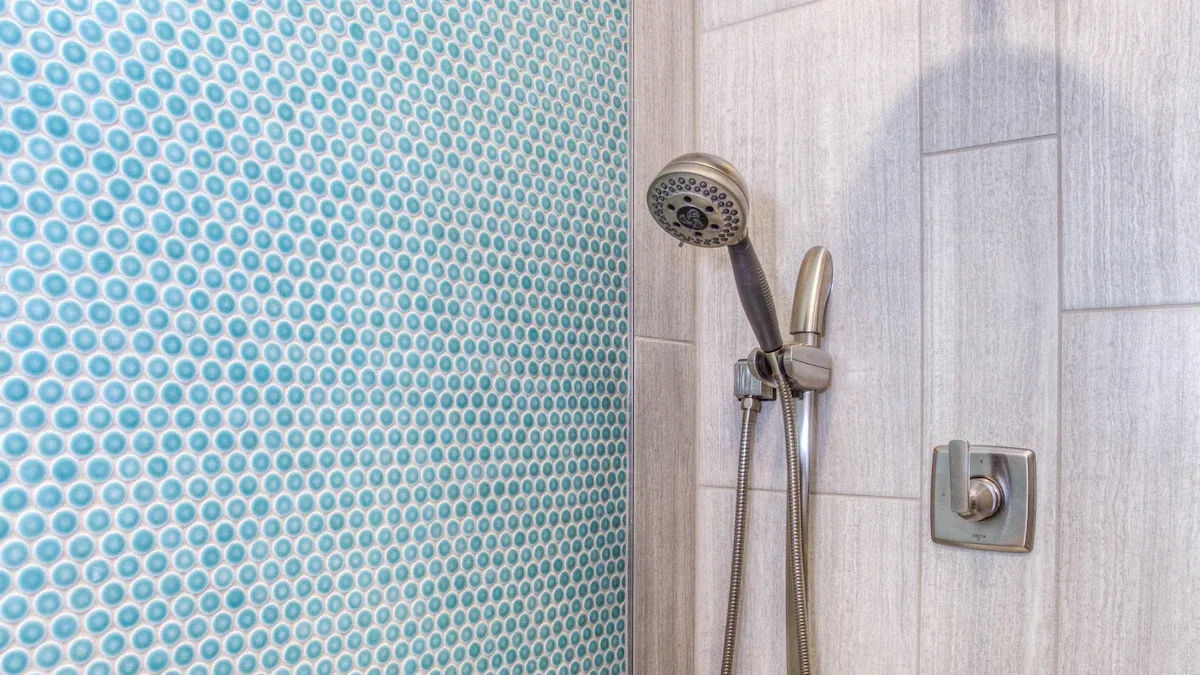
Water Usage Differences
Water-saving showerheads use less water than regular ones. Most traditional showerheads use about 2.5 gallons each minute. WaterSense showerheads use only 1.5 to 2.0 gallons per minute. This means you use much less water every time you shower.
The table below shows how much water each type uses:
Aspect |
Traditional Shower Head |
Water-Saving (Low-Flow) Shower Head |
|---|---|---|
Flow Rate (Gallons Per Minute) |
2.5 GPM |
1.5 to 2.0 GPM |
Water Usage per 10-minute Shower |
25 gallons |
15 to 20 gallons |
Monthly Water Usage (Individual, 175 minutes) |
~440 gallons |
~262 gallons |
Percentage Monthly Savings |
N/A |
About 40% to 60% |
Annual Water Savings (Individual) |
N/A |
About 2,000 gallons |
Low flow showerheads help families use 20% to 40% less water. Less water goes down the drain with every shower. These showerheads help homes and towns save water.
Real-World Savings
Switching to a low-flow showerhead saves real water. A family of four can save up to 3,000 gallons each year. Using less hot water also means lower energy bills. Some people think low flow showerheads feel weak, but new ones still give a strong shower.
Low-flow showerheads also help save energy by using less hot water. This means less pollution and a cleaner planet. People who use these showerheads often see smaller water bills and fewer plumbing problems.
Tip: Pick a low-flow showerhead to save water and money every month.
Low flow showerheads work well and save a lot. They help you use less water, spend less, and protect nature. These showerheads make it easy for everyone to save water at home.
Choosing a Water-Saving Shower Head
Key Features to Consider
When you pick a water-saving shower head, look at a few things. Science shows these features help you save the most water.
Flow Rate: Pick a showerhead that uses 2.0 gallons per minute or less. This helps you really save water.
Certifications: Find showerheads with EPA or WaterSense labels. These labels mean the showerhead saves water for sure.
Spray Patterns: Choose one with different spray settings. This lets you change how the water feels and spreads.
Installation: Get a model that matches your skills. You can put it in yourself or ask someone to help.
Customer Reviews: Read what other people say. This tells you if the showerhead works well in real life.
Low-flow showerheads use 25% to 60% less water than old ones. A family of four can save up to 9,000 gallons every year. This also means you pay less for hot water. It is good for the planet too. More people want eco-friendly things for their homes now.
Installation Tips
Most people can put in a new showerhead easily. Experts say to follow these steps for fixed showerheads:
Get tools like a wrench and plumber’s tape.
Take off the old showerhead by turning it left.
Clean the shower arm threads to get rid of old tape or dirt.
Wrap plumber’s tape around the threads to stop leaks.
Screw on the new showerhead by hand. Use a wrench to make it tight.
Check for leaks and fix if needed.
Some walls, like tile or prefab, need extra care. Guides from experts say to follow these steps to stop leaks or damage. Many water-saving showerheads have simple instructions for you to follow.
Tip: Always read the maker’s guide before you start. This helps you put it in right and keeps you safe.
Certifications
Certifications show a showerhead meets tough water-saving rules. The WaterSense label from the EPA means it uses 2.0 gallons per minute or less. It also passes tests for spray strength and coverage. Other certifications, like NSF/ANSI 61, check water safety and quality. Picking certified showerheads helps families know the water-saving parts really work. Certified products help the earth and support a healthy future.
Water-saving showerheads use science to help people use less water. They still make showers feel nice and safe for your health. These showerheads have flow restrictors, air-infusion, and smart technology. These parts help save water and energy at home. Some showerheads also have special filters. These filters make water cleaner for your skin and hair. People who use these showerheads pay less for water. They also help the planet by saving water. Experts say water-saving showerheads are good for green homes. They help people live in a more eco-friendly way. When buying a new showerhead, check for certifications. You should also read reviews before you choose one.
FAQ
How do water-saving shower heads reduce water use?
Water-saving shower heads have flow restrictors, aerators, and special nozzles. These parts control how much water comes out. The shower still feels strong and nice. People use less water every time they shower.
Can a water-saving shower head affect water pressure?
Most new water-saving shower heads keep the pressure high. They use air-mixing and smart nozzle shapes. Users still get a full and strong spray. Most people do not notice any change in pressure.
Do filtered shower heads help with skin and hair health?
Filtered shower heads take out chlorine and heavy metals. This helps skin stay soft and hair look shiny. People with sensitive skin often have less dryness and less irritation after using a filtered shower head.
How often should someone replace the filter in a shower head?
Usage Level |
Recommended Replacement |
|---|---|
High (large family) |
Every 2 months |
Medium (average use) |
Every 2-3 months |
Low (single user) |
Every 3 months |
Changing the filter keeps the water clean and healthy.
Are water-saving shower heads hard to install?
Most water-saving shower heads fit regular pipes. People can put them in with simple tools. The product comes with instructions. Many people finish putting it in under 10 minutes.
